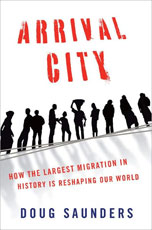Doug Saunders is an award-winning journalist and the European bureau chief of Globe and Mail. He says the big story of the twenty-first century is the gigantic and unrelenting stream of people from rural villages into cities. This vast and unprecedented movement involves two to three billion people, perhaps a third of the world's population. It is having a shattering effect on family life with the end result being an end to continuous population growth. Since cites around the world have not been prepared for this large influx of strangers, they have been forced into slums, not adapted well to urban living, been unable to find work, and plunged into poverty. But the deep yearning that brought them to a new life keeps them going in the face of setbacks, disappointments, and constant humiliations.
With great energy and solid reporting skills, Saunders visited 20 of these cities including Santa Maria, Rio de Janeiro, Brazil; Shuilin, Sichuan, China; Biswanath, Sylhet, Bangladesh; Kibera, Nairobi, Kenya; Kolhewadi, Ratnagiri, India; and Mulund, Mumbai. The author calls these transitional places "arrival cities" where anything can happen ranging from economic boom to the explosion of violence and widespread chaos. Those who migrate from rural villages are escaping from" the largest single killer of humans today, the greatest source of malnutrition, infant mortality, and reduced lifespans." According to the World Food Programme, three-quarters of the world's billion people living in hunger are peasant farmers.
Moving from city to city, Saunders explains the changes experienced by rural newcomers as they struggle to find a place to live through a network of people from their village; as they seek work largely through self-employment in an informal economy; as they send money home to relatives and others left behind; as they contend with prejudice and anger at their presence in cites. Saunders reports that in 2005, almost three-quarters of developing world governments told researchers that they felt they should restrict rural urban migration. These leaders also worry that their arrival cities will capitulate to destructive forces such has the drug gangs in Brazil, Hindu nationalists in Mumbai, and Islamic extremists in Europe.
Saunders covers another fascinating subject: the coming labor shortage in many countries by 2030. China is already facing this problem by starting programs to import workers from sub-Saharan Africa and the Indian subcontinent. Soon the very countries so opposed to immigrants will find themselves engaged in active recruitment of them.
It is impossible in this short review to convey the breadth and depth of these profiles of so many cities. Saunders makes it clear that one size does not fit all. He has done us a favor in researching and delivering such an excellent report on arrival cities and the determined newcomers who are struggling to make a life for themselves in them.
